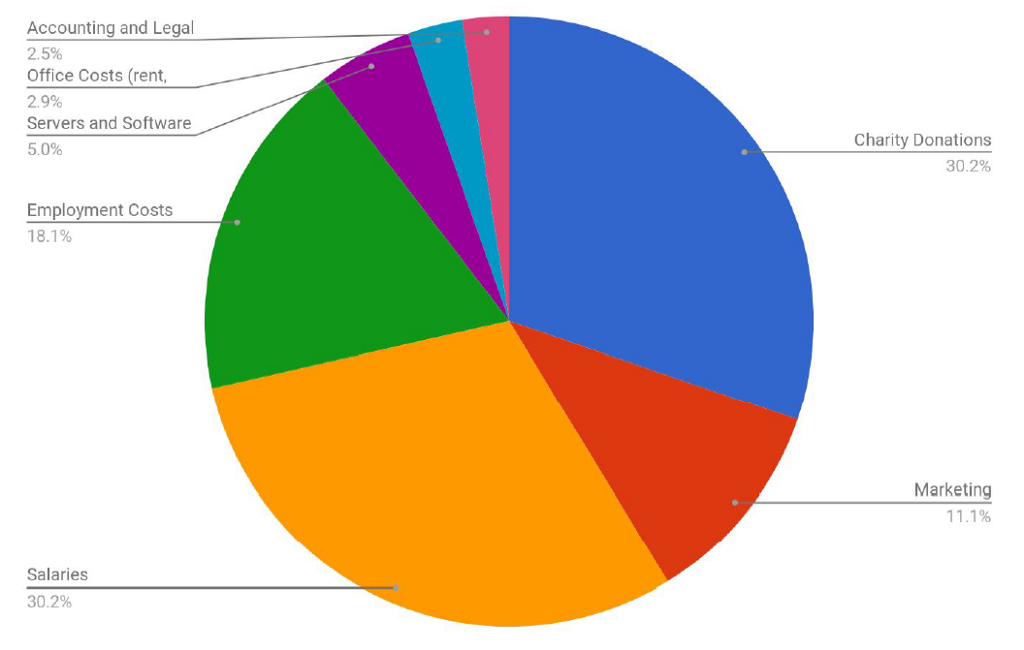Tab for a Cause is ineffective and you have better options
Tab for a cause is a browser extension to collect money for charity through ads. The principle is easy: every time you open a tab some ads are shown to you. The more ads you see, the more currency you generate, which is then given to charity. Sounds good, too bad it’s flawed. If you have been using it, here are some arguments to uninstall it.
 Photo by Richy Great on Unsplash
Photo by Richy Great on Unsplash
Less then a third of the revenue actually goes to charity
Tab for Cause is committed to give at least 30% of their revenue to charity:
[…] No matter what our costs are, we give at least 30% of our revenue to charity. Historically we’ve given upwards of 90%.
In practice “at least 30%” meant 30,2% from January 2018 to March 2020 (the last data available as of writing in October 2020). The previous financial statements from 2011 to 2017 only include the amount given to charity without the gross revenue. The quote “Historically we’ve given upwards of 90%.” probably refers to an early stage of the project when the founders were working for free.
| Year | Quarter | Revenue | Charity % | Charity Value |
|---|---|---|---|---|
| 2018 | 1 | $139,460.00 | 30.0% | $41,838.00 |
| 2018 | 2 | $114,519.70 | 30.0% | $34,355.91 |
| 2018 | 3 | $123,098.00 | 30.0% | $36,929.40 |
| 2018 | 4 | $184,647.90 | 30.0% | $55,394.37 |
| 2019 | 1 | $139,395.93 | 30.0% | $41,818.78 |
| 2019 | 2 | $153,435.84 | 30.0% | $46,030.75 |
| 2019 | 3 | $149,438.00 | 30.0% | $44,831.40 |
| 2019 | 4 | $173,035.00 | 31.0% | $53,640.85 |
| 2020 | 1 | $116,657.00 | 30.2% | $35,239.80 |
| Sum | $1,293,687.37 | 30.2% | $390,079.26 |
The rest of the revenue covers the costs to run the business. According to the financial statement for the first quarter of 2020, about half the revenue was spent on employment costs and salaries, 11.1% on marketing, and the rest on other expenses.
 Source: Q1 2020 Financial statement
Source: Q1 2020 Financial statement
The revenue per user is too low to justify Tab for a Cause
I couldn’t find any official figures on the current user base size: not on the website, nor on the articles here on Medium, nor anywhere else. I assumed 200,000 users, a conservative estimate which only includes Google Chrome’s users and ignores all other browsers.
 As of October 2020, Tab for a Cause’s extension for Google Chrome has at least 200,000 users.
As of October 2020, Tab for a Cause’s extension for Google Chrome has at least 200,000 users.
In 2019 Tab for a Cause raised $ 615.304,77 of revenue, $ 186.321,78 of which went to charity. That is $3.08 of revenue and $ 0.93 to charity per user per year. Even if Tab for a Cause managed to run for free, you could outperform the average yearly contribution with the spare change in your pocket.
If you donate just $ 1 a year to a charity, you are more effective than the average Tab for a Cause user.
Saying “you were going to open the tab anyway” is not enough
One argument in favour of Tab for Cause can be that even if the contribution is low, it comes at no cost for the user. That is true if you don’t value your time and attention. Would you rather expose yourself to ads every time you open a tab for a whole year, or give $ 1 out of your wallet to charity? Watching ads has actual costs.
Even if you consider yourself completely immune to ads, that can’t be true on aggregate. If companies keep buying ads, that must mean that they get at least the same amount back as revenue. This effectively adds a level of inefficiency:
- Tab for a Cause’s users buy from companies based on the ads they saw.
- A fraction of the companies’ revenue goes to advertising agencies.
- A fraction of the advertising agencies’ revenue goes to Tab for a Cause.
- A fraction of Tab for a Cause’s revenue actually goes to charity.
Tab for a Cause provides a false sense of accomplishment
Tab for a Cause’s users can choose the charities to benefit through “hearts”, the inner currency collected while watching ads. This makes the extension feel better than it actually is. Compare:
Congrats! You collected 1,500 hearts to donate across these charities! You get to choose and make a difference!
with:
Congrats! After watching ads for a year, you generated $ 3 in revenue, of which $1.50 will pay us, $ 0.50 will keep the lights on, and $ 1 will go to some charity out of a selection we picked for you.
Any kind of accomplishment requires actual resources, time and effort. Browsing the internet doesn’t help, no matter how many extensions you install. Tab for a cause tricks you into thinking you’re helping, while your contribution to the world is actually meaningless.
Conclusion
I do believe that Tab for a Cause’s founders are acting in good faith. They are transparent about their financials and open sourced their code. You shouldn’t be discouraged into seeking ways to improve the world. Despite its flaws, Tab for a Cause still managed to donate something. The takeaway from this article should be that even small contributions can be more meaningful than expected.
If you felt good using Tab for a Cause, you can feel much better by replacing it with an ad blocker and donating $ 10 a year to a charity of your choice.